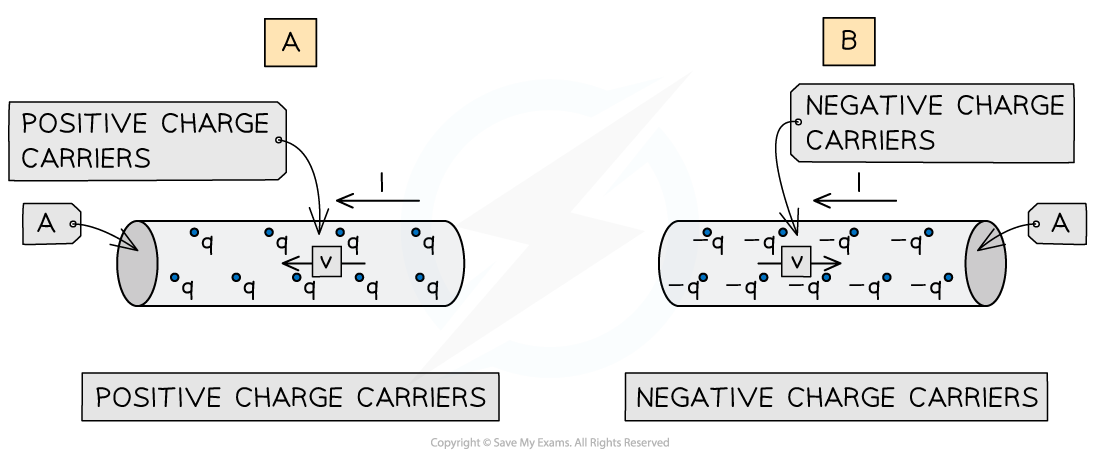Calculating Current & Drift Velocity
Drift Velocity
- In a conductor, the current is due to the movement of charge carriers
- The charge carriers can be negative or positive
- However current is always taken to be in the same direction
- Drift velocity is the average velocity of the charge carriers travelling through the conductor
- In conductors, the charge carrier is usually free electrons
- Free electrons only travel small distances before colliding with a metal ion
- Therefore they have a relatively slow drift velocity of ∼ 10−3 m s−1
- In the diagram below, the current in each conductor is from right to left
- In diagram A (positive charge carriers), the drift velocity is in the same direction as the current
- In diagram B (negative charge carriers), the drift velocity is in the opposite direction to the current

Conduction in a current-carrying conductor
- The density n represents the number of free charge carriers (electrons) per unit volume
- Conductors, such as metals, have a high value of n
- Insulators, such as plastics, have a low value of n
- Since the density of charge carriers is so large in conductors, the flow of current flow appears to happen instantaneously
The Transport Equation
- The current can be expressed in the transport equation:
- Where:
- I = current (A)
- n = number density (m−3)
- q = the charge of the charge carrier (C)
- v = drift velocity (m s−1)
- A = cross sectional area of the wire (m2), calculated using A = πr2
- The same equation is used whether the charge carriers are positive or negative
- A negative value for v will indicate current in the opposite direction to the charge carriers
- The transport equation shows that v is inversely proportional to n
- Since the more charge carriers available per unit volume the more the density will slow down their speed through the conductor
- The transport equation also shows that I is directly proportional to n
- Greater n means a greater charge is flowing and therefore a larger current I
- When the value of n is lower, the charge carriers must travel faster to carry the same current
Worked example
The number density of conduction electrons in a copper wire is 9.2 × 1028 m−3. The wire carries a current of 3.5 A and it has a cross-sectional area of 1.5 mm2.
Determine the average drift velocity of the electrons.
Answer:
Step 1: Consider the situation
- A copper wire is a conductor, and the free electrons are charge carriers
- Use the transport equation I = nqvA
Step 2: Rearrange the equation for drift speed v
Step 3: Substitute in values
- Current, I = 3.5 A
- Cross-sectional area, A = 1.5 mm2 = 1.5 ÷ 10002 = 1.5 × 10−6 m2
- Number density of conduction electrons, n = 9.2 × 1028 m−3
- Charge on an electron, q = 1.60 × 10−19 C (From the data sheet)
m s−1
mm s−1 (2 s.f.)


